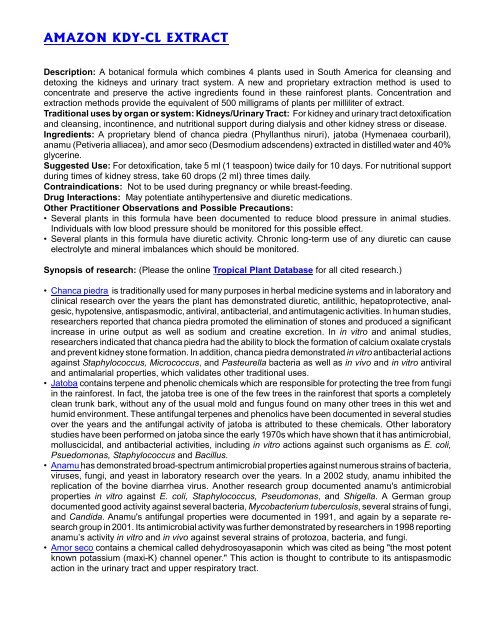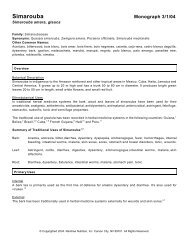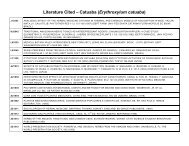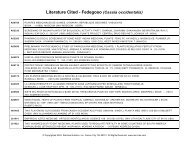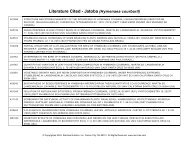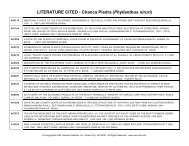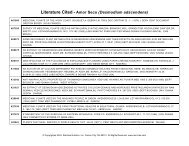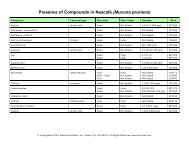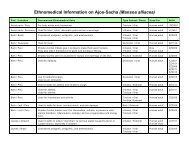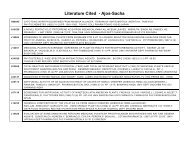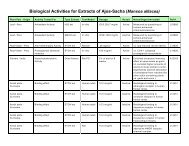Organ Specific Guide - Raintree Nutrition, Inc
Organ Specific Guide - Raintree Nutrition, Inc
Organ Specific Guide - Raintree Nutrition, Inc
You also want an ePaper? Increase the reach of your titles
YUMPU automatically turns print PDFs into web optimized ePapers that Google loves.
AMAZON KDY-CL EXTRACT<br />
Description: A botanical formula which combines 4 plants used in South America for cleansing and<br />
detoxing the kidneys and urinary tract system. A new and proprietary extraction method is used to<br />
concentrate and preserve the active ingredients found in these rainforest plants. Concentration and<br />
extraction methods provide the equivalent of 500 milligrams of plants per milliliter of extract.<br />
Traditional uses by organ or system: Kidneys/Urinary Tract: For kidney and urinary tract detoxification<br />
and cleansing, incontinence, and nutritional support during dialysis and other kidney stress or disease.<br />
Ingredients: A proprietary blend of chanca piedra (Phyllanthus niruri), jatoba (Hymenaea courbaril),<br />
anamu (Petiveria alliacea), and amor seco (Desmodium adscendens) extracted in distilled water and 40%<br />
glycerine.<br />
Suggested Use: For detoxification, take 5 ml (1 teaspoon) twice daily for 10 days. For nutritional support<br />
during times of kidney stress, take 60 drops (2 ml) three times daily.<br />
Contraindications: Not to be used during pregnancy or while breast-feeding.<br />
Drug Interactions: May potentiate antihypertensive and diuretic medications.<br />
Other Practitioner Observations and Possible Precautions:<br />
• Several plants in this formula have been documented to reduce blood pressure in animal studies.<br />
Individuals with low blood pressure should be monitored for this possible effect.<br />
• Several plants in this formula have diuretic activity. Chronic long-term use of any diuretic can cause<br />
electrolyte and mineral imbalances which should be monitored.<br />
Synopsis of research: (Please the online Tropical Plant Database for all cited research.)<br />
• Chanca piedra is traditionally used for many purposes in herbal medicine systems and in laboratory and<br />
clinical research over the years the plant has demonstrated diuretic, antilithic, hepatoprotective, analgesic,<br />
hypotensive, antispasmodic, antiviral, antibacterial, and antimutagenic activities. In human studies,<br />
researchers reported that chanca piedra promoted the elimination of stones and produced a significant<br />
increase in urine output as well as sodium and creatine excretion. In in vitro and animal studies,<br />
researchers indicated that chanca piedra had the ability to block the formation of calcium oxalate crystals<br />
and prevent kidney stone formation. In addition, chanca piedra demonstrated in vitro antibacterial actions<br />
against Staphylococcus, Micrococcus, and Pasteurella bacteria as well as in vivo and in vitro antiviral<br />
and antimalarial properties, which validates other traditional uses.<br />
• Jatoba contains terpene and phenolic chemicals which are responsible for protecting the tree from fungi<br />
in the rainforest. In fact, the jatoba tree is one of the few trees in the rainforest that sports a completely<br />
clean trunk bark, without any of the usual mold and fungus found on many other trees in this wet and<br />
humid environment. These antifungal terpenes and phenolics have been documented in several studies<br />
over the years and the antifungal activity of jatoba is attributed to these chemicals. Other laboratory<br />
studies have been performed on jatoba since the early 1970s which have shown that it has antimicrobial,<br />
molluscicidal, and antibacterial activities, including in vitro actions against such organisms as E. coli,<br />
Psuedomonas, Staphylococcus and Bacillus.<br />
• Anamu has demonstrated broad-spectrum antimicrobial properties against numerous strains of bacteria,<br />
viruses, fungi, and yeast in laboratory research over the years. In a 2002 study, anamu inhibited the<br />
replication of the bovine diarrhea virus. Another research group documented anamu's antimicrobial<br />
properties in vitro against E. coli, Staphylococcus, Pseudomonas, and Shigella. A German group<br />
documented good activity against several bacteria, Mycobacterium tuberculosis, several strains of fungi,<br />
and Candida. Anamu's antifungal properties were documented in 1991, and again by a separate research<br />
group in 2001. Its antimicrobial activity was further demonstrated by researchers in 1998 reporting<br />
anamu’s activity in vitro and in vivo against several strains of protozoa, bacteria, and fungi.<br />
• Amor seco contains a chemical called dehydrosoyasaponin which was cited as being "the most potent<br />
known potassium (maxi-K) channel opener." This action is thought to contribute to its antispasmodic<br />
action in the urinary tract and upper respiratory tract.


